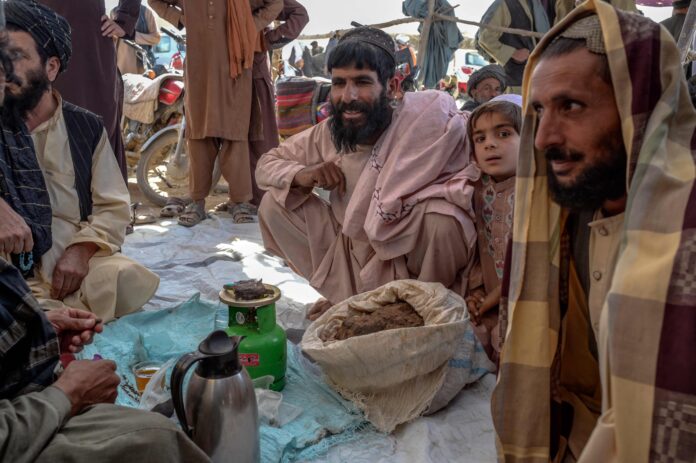Historically, Afghanistan has been the epicentre of poppy cultivation and a leading source of the global opiates supply. Even today Afghanistan is considered as one of the world’s largest country in the illegal cultivation and production of narcotics, and without a doubt its effects are not limited to Afghanistan only, but the smuggling of narcotics has become a major threat to the other countries in the region and beyond. The variety of narcotics grown and made in Afghanistan include opium, hashish, and synthetic drugs, which are smuggled internationally through complex and extensive networks.
After the Taliban regained power in August 2021, the situation in Afghanistan has changed significantly. Afghanistan has started moving towards the production of synthetic drugs, particularly methamphetamine, which is more discreet and highly profitable. This worrying trend is supported by the increasing number of synthetic drug seizures in Pakistan.
Pakistan’s geographical proximity to Afghanistan puts Pakistan at a greater risk. Sharing a long border of 2,611 km, Pakistan faces greater vulnerability to drug trafficking due to ever growing narcotics markets in Afghanistan. The inflow and outflow of Afghan drugs continue to pose a grave threat to the health, safety, and well-being of the Pakistani people, especially the younger generation.
Afghanistan takes advantage of its long and porous border with Pakistan to smuggle narcotics to Pakistan and for the rest of the world, it has devised and deployed an elaborate network, while utilizing well-orchestrated routes and contacts, to supply drugs of all kinds. For example, Afghanistan annually supplies 60 to 80 percent of the opium to the US and European markets. According to the United Nations Office for Drugs and Crime, after the Taliban’s return to power in 2021, there was a 32 percent increase in opium cultivation in Afghanistan, making it the world’s third-largest opium-producing country.
In the case of Pakistan, Afghanistan’s involvement is supported by the fact that, since 2018, Pakistan’s Anti- Narcotics Force has arrested 340 foreign nationals, including 184 Afghans, who were involved in drug trafficking. The presence of an estimated 1.7 million declared Afghan refugees, with the actual figure potentially surpassing 4 million, creates a favourable environment for Afghan drug smugglers exploiting linguistic, cultural, and geographical ties.
It is worth mentioning here that Pakistan has maintained “poppy free status” since 2001 through joint efforts of provincial governments and Law Enforcement Agencies (LEAs). Poppy eradication is one of the key strands of Pakistan’s Anti- Narcotics Policy 2019. However, alleviation of the drug menace remains a shared responsibility demanding whole of nation effort. Only through a unified and determined effort can Pakistan hope to break the stranglehold of Afghan narcotics and ensure the health, safety, and well-being of its people.
Moreover, the Afghan Transit Trade under the APTTA has also been implicated in the smuggling of contraband, including precursor chemicals destined for Afghanistan. Recently, an Afghan-destined container that originated from India, containing 9.5 million Alprazolam tablets, was held at the Karachi seaport, further highlighting the scale of this illicit trade.
Furthermore, the economic impact of the illegal drug trade in Pakistan is staggering, generating an estimated $2 billion each year. The UNODC calculates that over 800,000 Pakistanis aged 15 to 64 regularly use heroin, consuming an estimated 44 tons annually. The supply chain of which traces back to Afghanistan, the source of a substantial portion of the world’s heroin.
But the dangers associated with narcotics go beyond their health, and economical effects. A concerning connection has emerged between drug activities and terrorism. It is also noteworthy that the biggest beneficiary of the revenue generated from drug smuggling under the patronage of the Afghan Taliban are terrorist organizations like al-Qaeda and the Fitna-Al-Khawarij (FAK). There is strong evidence that the FAK, Baloch Liberation Army, and Balochistan Liberation Front are involved in the drug trade and smuggling, which remains a major source of their funding.
The effects of these nexus are evident from the UNODC’s latest data, which paints a grim picture of this narco-trade on Pakistan’s severe drug addiction crisis. According to the report, the number of drug users remains alarmingly high, with an estimated several million individuals engaged in substance abuse. Cannabis remains the most commonly used drug, while injection drug abuse continues to escalate, heightening concerns about potential HIV cases in Pakistan.
The alarming rate of 40,000 new drug users per year solidifies Pakistan’s status as one of the most drug-affected nations globally. The surge in injection drug users in Punjab is especially troubling, soaring from an estimated 90,000 in 2007 to around 500,000 by 2014. After Punjab the spike has been most visible in the restive northwestern province of Khyber Pakhtunkhwa, which borders Afghanistan, a major supplier of meth in the region.
Furthermore, the narcotics threat is gradually transitioning from the physical to the cyber domain. Dark web and social media networks are becoming contact platforms for the marketing, distribution, and selling/ buying of illicit drugs. There have been cases where the use of cryptocurrency has been employed to avoid financial scrutiny and monitoring by government agencies. This emerging trend necessitates robust cyber capabilities, including digital forensics and denial, to effectively combat these evolving challenges.
To address the multifaceted drug problem, including drug-related transnational organized crimes and narco-terrorism, Pakistan’s Anti-Narcotics Policy of 2019 serves as a guiding document. The policy, while laying out several objectives, puts emphasis on three main priorities: supply reduction, demand reduction and international cooperation, developed in accordance with international best practices.
It is worth mentioning here that Pakistan has maintained “poppy free status” since 2001 through joint efforts of provincial governments and Law Enforcement Agencies (LEAs). Poppy eradication is one of the key strands of Pakistan’s Anti- Narcotics Policy 2019. However, alleviation of the drug menace remains a shared responsibility demanding whole of nation effort. Only through a unified and determined effort can Pakistan hope to break the stranglehold of Afghan narcotics and ensure the health, safety, and well-being of its people.





















